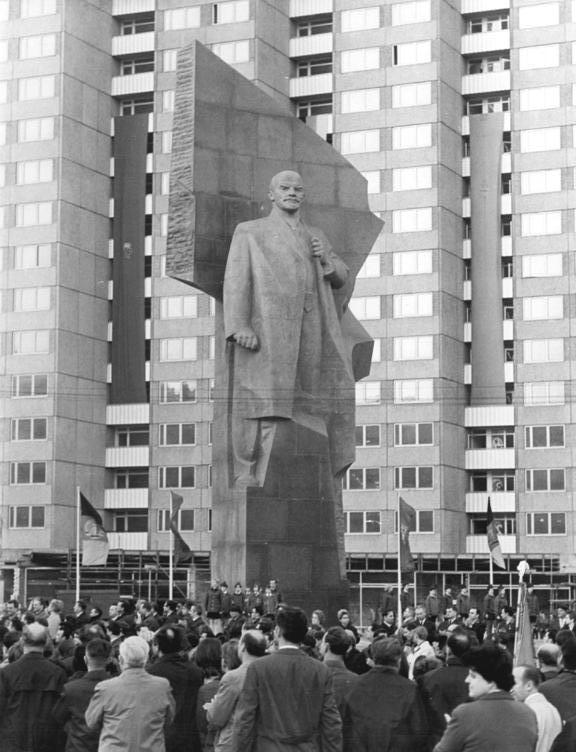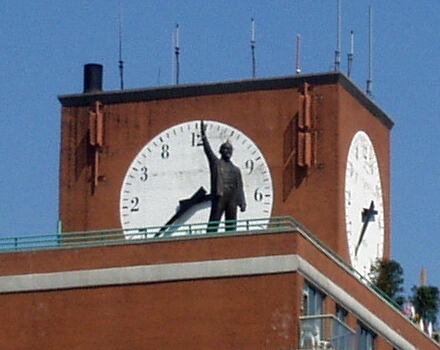|
Lenin Monument (Berlin)
The Lenin Monument (German: ''Lenin-Denkmal'') was a monument to Vladimir Lenin in East Berlin created by the Soviet Russian sculptor Nikolai Tomsky. It was inaugurated on April 19, 1970 to commemorate the 100th anniversary of Lenin's birth. After German reunification, the district council of Friedrichshain voted for its removal despite demonstrations and petitions from neighborhood residents and preservationists. The demolition process began in November 1991, and by February 1992 the monument was completely dismantled and its fragments buried on the outskirts of Berlin. In 2015, the head of the statue was excavated, and since 2016 it has been on display at Berlin’s Spandau Citadel as part of a permanent exhibition of Berlin political monuments. Background The monument was created by Nikolai Tomsky, a Soviet Russian sculptor who is responsible for a number of monumental statues dedicated to Russian historical figures, including several monuments to Lenin. At the time of the ... [...More Info...] [...Related Items...] OR: [Wikipedia] [Google] [Baidu] |
Nikolai Tomsky
Nikolai Vasilyevich Tomsky (russian: Никола́й Васи́льевич То́мский b. , Ramushevo, Novgorod Governorate d. 22 November 1984 - Moscow) was a much-decorated Soviet sculptor, designer of many well-known ceremonial monuments of the Socialist Realism era. Biography Born in the village of Staro Ramushevo in Novgorod province, into a blacksmith's family, Tomsky studied in Leningrad. In 1927, graduated from the Arts and Crafts College. The sculptor first came to attention with his memorial to Sergey Kirov, a heroic bronze with friezes around the base, for which he won the 1941 Stalin Prize. Thereafter his career developed in an official direction; he would be eventually tasked to re-design Lenin's own sarcophagus, produce Stalin's bust at Stalin's grave, and produce at least five major statues of Lenin throughout the Soviet Union. His distinctive red-granite Lenin stood in the Leninplatz of East Berlin from 1970 to 1992. Tomsky became a full member of t ... [...More Info...] [...Related Items...] OR: [Wikipedia] [Google] [Baidu] |
Bundesarchiv B 145 Bild-F089663-0031, Berlin, Lenin-Denkmal Auf Dem Leninplatz
The German Federal Archives or Bundesarchiv (BArch) (german: Bundesarchiv) are the National Archives of Germany. They were established at the current location in Koblenz in 1952. They are subordinated to the Federal Commissioner for Culture and the Media ( Claudia Roth since 2021) under the German Chancellery, and before 1998, to the Federal Ministry of the Interior. On 6 December 2008, the Archives donated 100,000 photos to the public, by making them accessible via Wikimedia Commons. History The federal archive for institutions and authorities in Germany, the first precursor to the present-day Federal Archives, was established in Potsdam, Brandenburg in 1919, a later date than in other European countries. This national archive documented German government dating from the founding of the North German Confederation in 1867. It also included material from the older German Confederation and the Imperial Chamber Court. The oldest documents in this collection dated back to the year ... [...More Info...] [...Related Items...] OR: [Wikipedia] [Google] [Baidu] |
Removed Statues
Remove, removed or remover may refer to: * Needle remover * Polish remover * Staple remover * Remove (education) * The degree of cousinship, i.e. "once removed" or "twice removed" - see Cousin chart See also * Deletion (other) * Moving (other) Moving or Movin' may refer to: Moving of goods * Relocation (personal), the process of leaving one dwelling and settling in another * Relocation of professional sports teams * Relocation (computer science) * Structure relocation Music Al ... * Removable (other) * Removal (other) * Strip (other) {{Disambig ... [...More Info...] [...Related Items...] OR: [Wikipedia] [Google] [Baidu] |
Statues In Germany
A statue is a free-standing sculpture in which the realistic, full-length figures of persons or animals are carved or cast in a durable material such as wood, metal or stone. Typical statues are life-sized or close to life-size; a sculpture that represents persons or animals in full figure but that is small enough to lift and carry is a statuette or figurine, whilst one more than twice life-size is a colossal statue. Statues have been produced in many cultures from prehistory to the present; the oldest-known statue dating to about 30,000 years ago. Statues represent many different people and animals, real and mythical. Many statues are placed in public places as public art. The world's tallest statue, ''Statue of Unity'', is tall and is located near the Narmada dam in Gujarat, India. Color Ancient statues often show the bare surface of the material of which they are made. For example, many people associate Greek classical art with white marble sculpture, but there is evidenc ... [...More Info...] [...Related Items...] OR: [Wikipedia] [Google] [Baidu] |
Monuments And Memorials To Vladimir Lenin
A monument is a type of structure that was explicitly created to commemorate a person or event, or which has become relevant to a social group as a part of their remembrance of historic times or cultural heritage, due to its artistic, historical, political, technical or architectural importance. Some of the first monuments were dolmens or menhirs, megalithic constructions built for religious or funerary purposes. Examples of monuments include statues, (war) memorials, historical buildings, archaeological sites, and cultural assets. If there is a public interest in its preservation, a monument can for example be listed as a UNESCO World Heritage Site. Etymology It is believed that the origin of the word "monument" comes from the Greek ''mnemosynon'' and the Latin ''moneo'', ''monere'', which means 'to remind', 'to advise' or 'to warn', however, it is also believed that the word monument originates from an Albanian word 'mani men' which in Albanian language means 'rememb ... [...More Info...] [...Related Items...] OR: [Wikipedia] [Google] [Baidu] |
Good Bye, Lenin!
''Good Bye Lenin!'' is a 2003 German tragicomedy film, directed by Wolfgang Becker. The cast includes Daniel Brühl, Katrin Sass, Chulpan Khamatova, and Maria Simon. The story follows a family in East Germany (GDR); the mother (Sass) is dedicated to the socialist cause and falls into a coma in October 1989, shortly before the November revolution. When she awakens eight months later in June 1990, her son (Brühl) attempts to protect her from a fatal shock by concealing the fall of the Berlin Wall and the collapse of communism in East Germany. Most scenes were shot at the Karl-Marx-Allee in Berlin and around Plattenbauten near Alexanderplatz. ''Good Bye Lenin!'' received numerous honours, including 2003's European Film Award for Best Film and German Film Award for Best Fiction Film. Plot The film is set in East Berlin, in the period from October 1989 to a few days after German reunification in October 1990. Alex Kerner lives with his mother Christiane, his sister Ariane, and ... [...More Info...] [...Related Items...] OR: [Wikipedia] [Google] [Baidu] |
List Of Statues Of Vladimir Lenin
This article is a list of current and former known monuments of Vladimir Lenin. Many of the monuments in former Soviet republics and satellites were removed after the fall of the Soviet Union, while some of these countries retained the thousands of Lenin monuments that were erected during the Soviet period as part of Lenin's cult of personality. Important regions and capital cities of countries are highlighted in bold. Africa Americas Antarctica Asia Europe Belarus * Babruysk * Baranovichi * Barysaw * Belaazyorsk * Brest * Bykhaw * Chachersk * Davyd-Haradok * Drahichyn * Dzyarzhynsk * Gomel * Grodno * Klimavichy * Kobryn * Lahoysk * Lida * Maladzyechna * Malaryta * Mazyr * Minsk * Mogilev * Navahrudak * Novolukoml * Orsha * Pastavy * Pinsk * Polotsk * Sapotskin * Salihorsk * Slonim * Smalyavichy * Smarhon' * Syanno * Talachyn * Vasilievichy * Verkhnyadzvinsk * Vitebsk * Zhlobin * Zhabinka Bulgaria *Shumen *Novgrad *Banya *Pet Mogili * Sofia – in Lenin S ... [...More Info...] [...Related Items...] OR: [Wikipedia] [Google] [Baidu] |
Berlin Wall
The Berlin Wall (german: Berliner Mauer, ) was a guarded concrete barrier that encircled West Berlin from 1961 to 1989, separating it from East Berlin and East Germany (GDR). Construction of the Berlin Wall was commenced by the government of the GDR on 13 August 1961. It included guard towers placed along large concrete walls, accompanied by a wide area (later known as the "death strip") that contained anti-vehicle trenches, beds of nails and other defenses. The Eastern Bloc portrayed the Wall as protecting its population from fascist elements conspiring to prevent the "will of the people" from building a socialist state in the GDR. The authorities officially referred to the Berlin Wall as the ''Anti-Fascist Protection Rampart'' (german: Antifaschistischer Schutzwall, ). The West Berlin city government sometimes referred to it as the "Wall of Shame", a term coined by mayor Willy Brandt in reference to the Wall's restriction on freedom of movement. Along with the separat ... [...More Info...] [...Related Items...] OR: [Wikipedia] [Google] [Baidu] |
Eberhard Diepgen
Eberhard Diepgen (born 13 November 1941) is a German lawyer and politician who served as Mayor of West Berlin from 1984 to 1989 and again as Mayor of (united) Berlin, from 1991 until 2001, as member of the Christian Democratic Union (CDU). Early life, education, and career Eberhard Diepgen was born on 13 November 1941 in the Berlin district of Wedding. He was to become the first native of Berlin in the office of governing mayor. After graduating from high school in 1960, Diepgen began studying law at the Free University of Berlin. During this time he was already politically active and joined the Christian Democratic Union (CDU) in 1962. As a member of the "Ring of Christian Democratic Students" (RCDS), he briefly chaired the "General Student Committee" (ASTA) of the Free University in 1963. After passing the first state examination in 1967, Diepgen worked as a trainee lawyer at the Berlin Higher Regional Court and was admitted to the bar in 1972 after the second state examin ... [...More Info...] [...Related Items...] OR: [Wikipedia] [Google] [Baidu] |
Revolutions Of 1989
The Revolutions of 1989, also known as the Fall of Communism, was a revolutionary wave that resulted in the end of most communist states in the world. Sometimes this revolutionary wave is also called the Fall of Nations or the Autumn of Nations, a play on the term Spring of Nations that is sometimes used to describe the Revolutions of 1848 in Europe. It also led to the eventual breakup of the Soviet Union—the world's largest communist state—and the abandonment of communist regimes in many parts of the world, some of which were violently overthrown. The events, especially the fall of the Soviet Union, drastically altered the world's balance of power, marking the end of the Cold War and the beginning of the post-Cold War era. The earliest recorded protests were started in Kazakhstan, then part of the Soviet Union, in 1986 with the Jeltoqsan, student demonstrations — the last chapter of these revolutions is considered to be in 1993 when Cambodia United Nations Transition ... [...More Info...] [...Related Items...] OR: [Wikipedia] [Google] [Baidu] |
Peter Abrassimov
Pyotr Andreievitch Abrasimov ( be, Пё́тр Андрэ́евіч Абра́сімаў, russian: Пётр Андреевич Абрасимов; 1912–2009) was a Soviet Union, Soviet war hero and politician who became a career diplomat. He served his country as ambassador successively in China, France, Poland and East Germany. Life Abrasimov was born in Boguszewsk, a recently expanded but still small village in the eastern part of Belarusian history in the Russian Empire, Belarus. The village's economic importance had been much enhanced when the local land-owner agreed to the erection of a station along the new railway line, which had opened in 1902, linking Vitebsk, Žlobin and Orsha to the rapidly expanding rail network of the Russian Empire (which included Belarus). Pyotr Andreievitch's father was a farmer who fought in the First World War and in the ensuing Russian Civil War, Civil War that followed it in the Russian Empire. He was killed in fighting near Orsha while a memb ... [...More Info...] [...Related Items...] OR: [Wikipedia] [Google] [Baidu] |





